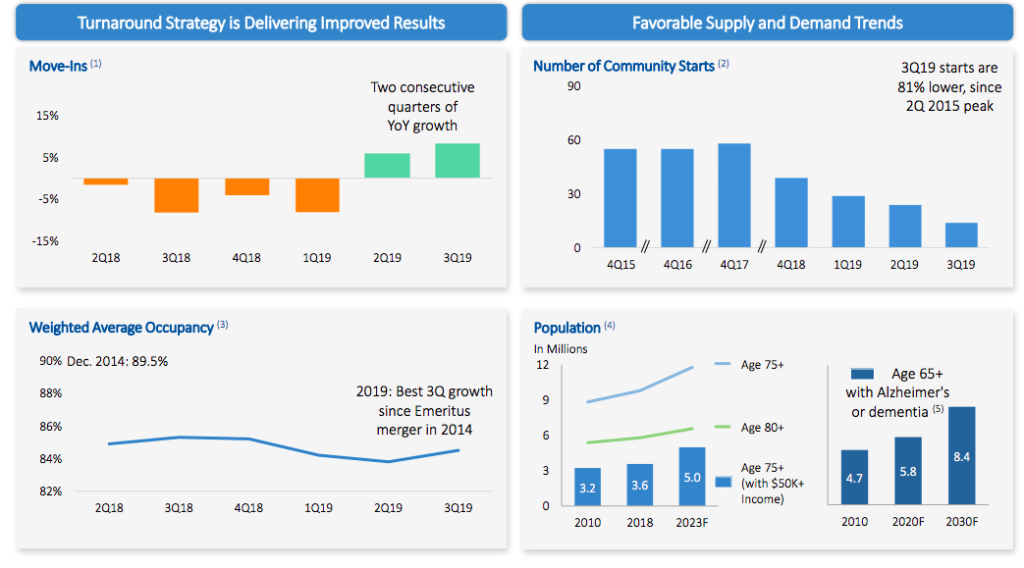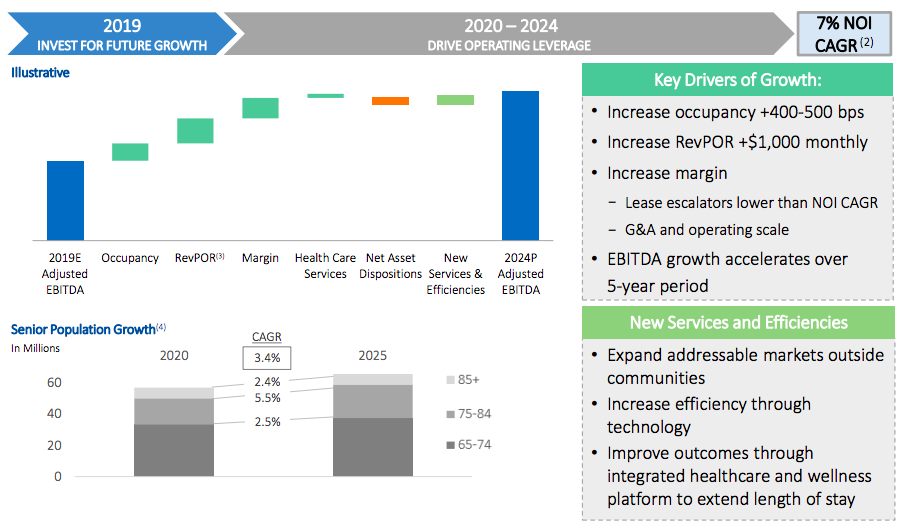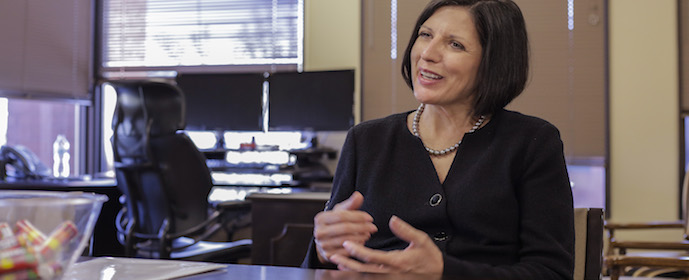Better supply-demand dynamics helped Brookdale Senior Living (NYSE: BKD) turn its recent occupancy trends positive — and the company is betting that these conditions will persist into the years ahead, leading it to release a five-year outlook.
However, the immediate picture is still mixed. The nation’s largest senior living provider was hit by high labor costs, pricing pressures and other challenges in Q3 2019.
The Brentwood, Tennessee-based operator has spent the better part of the past two years overhauling its operations and restructuring leases with its three largest real estate investment trust (REIT) partners, including recently announced transactions.
These moves set Brookdale up for continued improvement, according to President and CEO Cindy Baier. The company is aiming to achieve up to an 89.5% average occupancy rate for its consolidated, same-community portfolio by 2024, with a 7% net operating income (NOI) compound annual growth rate through that period, according to the five-year outlook released Tuesday.
“I am confident that the positive momentum we have seen over the past few quarters will continue,” Baier said during Brookdale’s earnings call Tuesday. “We have made a monumental shift in improving the culture over the past 20 months.”
Brookdale’s portfolio consisted of 794 communities in 45 states as of Sept. 30.
One of the company’s recent distractions was put to rest this quarter with the end of a heated proxy battle with activist investor Land & Buildings Investment Management. While the investment firm had sought to nominate former HCP CEO Jay Flaherty to Brookdale’s board of directors this year, it withdrew that nomination last month, paving the way for the election of two new board members, Vicki Freed and Guy Sansone.
Good headway on topline growth
Brookdale’s same-community average occupancy was 84.5% for the third quarter of 2019, an 80 basis point decrease compared to the 85.3% occupancy rate it saw this time last year. But the company gained 70 basis points over its second-quarter occupancy rate of 83.8%, and those trends are holding steady into the fourth quarter for now.
“Year to date, this is the best in-year, same-community occupancy growth since the Emeritus merger in 2014,” Baier said. “Our October occupancy continues this positive growth trend.”
In particular, the company logged a weighted average occupancy for its same-community assisted living and memory segment of 83.3% in the third quarter of 2019, a marked gain over the 82.3% occupancy it saw last quarter. Brookdale’s same-community independent living occupancy was 89.9% for the third quarter of this year.
Although the operator reported positive recent occupancy trends, other factors — such as wage inflation, higher operating costs and a lagging home health division — weighed on the company’s bottom line for the quarter.
The company’s facility operating expense increased $42.1 million, or 7.5%, in the third quarter of 2019, which Brookdale said was primarily the result of a 6.8% increase in labor expenses. Other operating expense increased 7.4% year-over-year mainly due to investments in marketing and advertising, higher insurance premiums and higher property remediation costs.
All told, Brookdale reported a net loss of $78.5 million for the third quarter in 2019, which is more than double the $37.1 million net loss it saw during the same period last year.
While those challenges cast a shadow over the company’s third-quarter earnings, there are other signs the company is on the right track, according to RBC Capital Markets Analyst Frank Morgan.
“Fortunately, management appears to be making good headway with its most pressing operational hurdle: achieving occupancy momentum and topline growth,” Morgan wrote in a note to investors.
Brookdale’s share price dropped nearly 5% Tuesday, and ended up at $7.26 by the time the market closed.
Turnaround update
Baier gave an update on Brookdale’s overall turnaround during the Tuesday earnings call.
In August, Baier told Senior Housing News the company’s ongoing turnaround effort was still making good progress. Since then, Brookdale has acquired an 18-property leased portfolio for $405 million and exited a joint venture agreement with HCP, a REIT now known as Healthpeak Properties (NYSE: PEAK).
As part of that deal, Healthpeak agreed to buy Brookdale’s joint venture interest in 13 entry-fee CCRCs for $277 million in net proceeds, and pay Brookdale $100 million to terminate its management agreements and transition them to Life Care Services, the management arm of parent company LCS.
Also on Tuesday, Frontline Management announced a joint effort with Onelife Investments to acquire three former Brookdale CCRCs in in South Carolina, Ohio and Arizona. The CCRCs, in total, add up to 782 units.
In the past year alone, Brookdale disposed of 27 owned communities and terminated triple-net lease obligations for 31 others. The operator also transitioned out of management arrangements for a net total of 109 communities.
“How are we doing? Put simply, the transformation we initiated last year is working,” Baier said Tuesday. “This quarter’s performance, and the recent transactions with HCP, provide further evidence of the progress we are making with our strategic plan.”
In particular, Baier named recent move-in and new supply trends as proof that the company is poised for growth in the coming years. And, more than 2,600 associates have returned to the company year to date, exemplifying the positive cultural shift occurring at Brookdale, she noted.
Brookdale reported its second consecutive period of year-over-year move-in growth in the third quarter of 2019. Total move-ins for the quarter grew 8% year over year, while first visits from internal sources increased 4%.
“We are seeing longer term benefits of building a lead pipeline, with move-ins occurring in both the month in which the lead occurred as well as months after the initial inquiry,” Baier said. “I couldn’t be more excited with our move-in progress two quarters in a row.”
Still, move-outs were “not where we wanted them to be,” she added.
Brookdale also touted recent NIC data showing that the number of construction starts within 20 minutes of its communities was 81% lower than during its peak in the second quarter of 2015. Openings near Brookdale communities were also down by 35% when compared with its peak during the second quarter of 2017.
“We are seeing around our communities the number of openings coming down,” Baier said. “What that tells me is, we’ve got much less competitive pressure around our communities, and that gives us great confidence in 2020.”
That message comes in the wake of comments from Ventas (NYSE: VTR) CEO Debra Cafaro last week, who relayed that a combination of market dynamics, particularly pricing, led to pain in its senior housing operating portfolio.
To that end, Baier did acknowledge some challenges on rates in select markets, but added that Brookdale has “very strong pricing power on a nationwide basis.”
 Brookdale Senior Living
Brookdale Senior LivingNew strategic outlook
Additionally, Brookdale released its five-year strategic outlook, which it first presented to its board of directors over the summer.
“As soon we could see our way forward … we wanted to get it out as quickly as possible,” Baier noted of the five-year outlook.
By 2024, the operator seeks to have grown its average occupancy rate by 400 to 500 basis points to nearly 90%, increased its revenue per occupied room (RevPOR) by more than $1,000 per month and lowered its general and administrative expenses, among other goals.
The company is targeting a 7% net operating income compound annual growth rate for its same-community portfolio through 2024.
Overall, Baier sees a more favorable macroeconomic picture for supply-demand dynamics in the years ahead — both in the industry and around its communities — giving her confidence that Brookdale won’t miss the mark.
“We’ve been looking at our proprietary analysis all around our communities for the last 20 months, trying to figure out exactly when the competitive environment was going to turn,” Baier said. “We called that it was going to turn in 2019, and we now have objective evidence … that it has turned.”
For the more immediate year ahead, Brookdale expects positive trends will drive more improvements in occupancy, rate increases and a continuation of the recent supply-demand equilibrium.
The operator also expects labor cost increases to return to more in-line results, and to better scale its general and administrative expenses with a leaner senior housing portfolio.
 Brookdale Senior Living
Brookdale Senior LivingPossible headwinds for 2020 include a virulent flu season, more reductions in managed communities and a tight labor market.
“We have great confidence in the five-year plan, which we introduced today because of the powerful upside for senior living, and the progress we’re making to improve our operations,” Baier said.
Companies featured in this article:
Brookdale Senior Living, HCP, Healthpeak Properties, Land and Buildings, Land and Buildings Investment Management LLC


